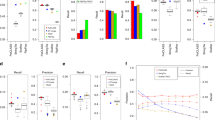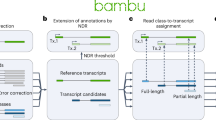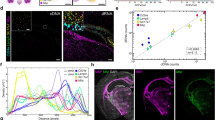Abstract
Rapid amplification of cDNA ends (RACE) is a widely used approach for transcript identification. Random clone selection from the RACE mixture, however, is an ineffective sampling strategy if the dynamic range of transcript abundances is large. To improve sampling efficiency of human transcripts, we hybridized the products of the RACE reaction onto tiling arrays and used the detected exons to delineate a series of reverse-transcriptase (RT)-PCRs, through which the original RACE transcript population was segregated into simpler transcript populations. We independently cloned the products and sequenced randomly selected clones. This approach, RACEarray, is superior to direct cloning and sequencing of RACE products because it specifically targets new transcripts and often results in overall normalization of transcript abundance. We show theoretically and experimentally that this strategy leads indeed to efficient sampling of new transcripts, and we investigated multiplexing the strategy by pooling RACE reactions from multiple interrogated loci before hybridization.
This is a preview of subscription content, access via your institution
Access options
Subscribe to this journal
Receive 12 print issues and online access
$259.00 per year
only $21.58 per issue
Buy this article
- Purchase on Springer Link
- Instant access to full article PDF
Prices may be subject to local taxes which are calculated during checkout





Similar content being viewed by others
Accession codes
References
Adams, M.D., Soares, M.B., Kerlavage, A.R., Fields, C. & Venter, J.C. Rapid cDNA sequencing (expressed sequence tags) from a directionally cloned human infant brain cDNA library. Nat. Genet. 4, 373–380 (1993).
Gerhard, D.S. et al. The status, quality, and expansion of the NIH full-length cDNA project: the Mammalian Gene Collection (MGC). Genome Res. 14, 2121–2127 (2004).
Kawai, J. et al. Functional annotation of a full-length mouse cDNA collection. Nature 409, 685–690 (2001).
Carninci, P. et al. The transcriptional landscape of the mammalian genome. Science 309, 1559–1563 (2005).
Bonaldo, M.F., Lennon, G. & Soares, M.B. Normalization and subtraction: two approaches to facilitate gene discovery. Genome Res. 6, 791–806 (1996).
Soares, M.B. et al. Construction and characterization of a normalized cDNA library. Proc. Natl. Acad. Sci. USA 91, 9228–9232 (1994).
Thill, G. et al. ASEtrap: a biological method for speeding up the exploration of spliceomes. Genome Res. 16, 776–786 (2006).
Watahiki, A. et al. Libraries enriched for alternatively spliced exons reveal splicing patterns in melanocytes and melanomas. Nat. Methods 1, 233–239 (2004).
Harrow, J. et al. GENCODE: producing a reference annotation for ENCODE. Genome Biol. 7 (Suppl 1), S4.1–S4.9 (2006).
Shiraki, T. et al. Cap analysis gene expression for high-throughput analysis of transcriptional starting point and identification of promoter usage. Proc. Natl. Acad. Sci. USA 100, 15776–15781 (2003).
Ng, P. et al. Gene identification signature (GIS) analysis for transcriptome characterization and genome annotation. Nat. Methods 2, 105–111 (2005).
Peters, L.M. et al. Signatures from tissue-specific MPSS libraries identify transcripts preferentially expressed in the mouse inner ear. Genomics 89, 197–206 (2007).
Roma, G. et al. A novel view of the transcriptome revealed from gene trapping in mouse embryonic stem cells. Genome Res. 17, 1051–1060 (2007).
Kapranov, P. et al. RNA maps reveal new RNA classes and a possible function for pervasive transcription. Science 316, 1484–1488 (2007).
Birney, E. et al. Identification and analysis of functional elements in 1% of the human genome by the ENCODE pilot project. Nature 447, 799–816 (2007).
Denoeud, F. et al. Prominent use of distal 5′ transcription start sites and discovery of a large number of additional exons in ENCODE regions. Genome Res. 17, 746–759 (2007).
Kapranov, P. et al. Examples of the complex architecture of the human transcriptome revealed by RACE and high-density tiling arrays. Genome Res. 15, 987–997 (2005).
Frohman, M.A., Dush, M.K. & Martin, G.R. Rapid production of full-length cDNAs from rare transcripts: amplification using a single gene-specific oligonucleotide primer. Proc. Natl. Acad. Sci. USA 85, 8998–9002 (1988).
Reymond, A. et al. Human chromosome 21 gene expression atlas in the mouse. Nature 420, 582–586 (2002).
The ENCODE Project Consortium. The ENCODE (ENCyclopedia Of DNA Elements) Project. Science 306, 636–640 (2004).
The ENCODE Project Consortium. Identification and analysis of functional elements in 1% of the human genome by the ENCODE pilot project. Nature 447, 799–816 (2007).
Kodzius, R. et al. CAGE: cap analysis of gene expression. Nat. Methods 3, 211–222 (2006).
Parra, G. et al. Tandem chimerism as a means to increase protein complexity in the human genome. Genome Res. 16, 37–44 (2006).
Parra, G., Blanco, E. & Guigo, R. GeneID in Drosophila. Genome Res. 10, 511–515 (2000).
Rozen, S. & Skaletsky, H. Primer3 on the WWW for general users and for biologist programmers. Methods Mol. Biol. 132, 365–386 (2000).
Acknowledgements
The project at Institut Municipal d'Investigació Mèdica, Center for Genomic Regulation (CRG), the Universities of Lausanne and Geneva, and Affymetrix was supported by grants U01HG003150 and U01HG003147 from the US National Human Genome Research Institute, National Institutes of Health; at IMIM and CRG also funded by grant BIO2006-03380 from the Spanish Ministry of Education and Science and from the European BioSapiens Consortium; at the Universities of Lausanne and Geneva also funded by the Swiss National Science Foundation, the EU AnEUploidy project and the National Center of Competence in Research Frontiers in Genetics; and at Affymetrix also funded by the National Cancer Institute, National Institutes of Health (N01-CO-12400) and by Affymetrix, Inc. The portion of this work carried out at Center for Cancer Systems Biology was funded by a grant from the Ellison Foundation (to M.V.) and as Institute Sponsored Research from the Dana Farber Cancer Institute Strategic Initiative. We acknowledge J.M. Oller for reviewing the probabilistic results and R. Castelo, C. Howald and D. Martin for useful suggestions.
Author information
Authors and Affiliations
Contributions
T.R.G., S.E.A., A.R., P.K. and R.G. participated in the overall design of the experiments and the subsequent analysis. A.R., C.U., C.W., P.M. and S.E.A. performed the RACE reactions. J.D., E.D. and P.K. performed the hybridization of the RACE reactions into tiling arrays. R.R.M., C.L., D.S., K.S.-A. and M.V. carried out the RT-PCRs, the cloning and sequencing of candidates. S.D., S.F., J.L., F.D. and R.G. developed software and carried out the bioinformatics analysis. M.C. developed the theoretical model for sampling and carried out the computational simulations. A.F. and J.H. provided the reference gene annotation and helped map the RT-PCR sequences to the genome.
Corresponding author
Ethics declarations
Competing interests
P.K., J.D., E.D. and T.R.G. are Affymetrix employees.
Supplementary information
Supplementary Text and Figures
Supplementary Figures 1–8, Supplementary Tables 1–2, Supplementary Methods, Supplementary Results (PDF 1195 kb)
Rights and permissions
About this article
Cite this article
Djebali, S., Kapranov, P., Foissac, S. et al. Efficient targeted transcript discovery via array-based normalization of RACE libraries. Nat Methods 5, 629–635 (2008). https://doi.org/10.1038/nmeth.1216
Received:
Accepted:
Published:
Issue Date:
DOI: https://doi.org/10.1038/nmeth.1216
This article is cited by
-
Evidence for widespread existence of functional novel and non-canonical human transcripts
BMC Biology (2023)
-
ChimPipe: accurate detection of fusion genes and transcription-induced chimeras from RNA-seq data
BMC Genomics (2017)
-
Genome-wide Identification and Characterization of Natural Antisense Transcripts by Strand-specific RNA Sequencing in Ganoderma lucidum
Scientific Reports (2017)
-
Intron retention and transcript chimerism conserved across mammals: Ly6g5b and Csnk2b-Ly6g5b as examples
BMC Genomics (2013)
-
Genome-wide functional annotation and structural verification of metabolic ORFeome of Chlamydomonas reinhardtii
BMC Genomics (2011)



